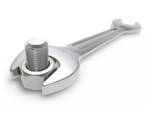What is the turn of the nut method, and does it apply to anchor bolts?
 The turn of the nut method is a very popular and reasonably reliable method for tensioning (F3125) A325 and A490 structural bolts without the need for expensive torque wrenches or tension measuring devices. It is a simple guide that tells the user to rotate the nut a specified amount depending on the bolt length and slope of the items being bolted together.
The turn of the nut method is a very popular and reasonably reliable method for tensioning (F3125) A325 and A490 structural bolts without the need for expensive torque wrenches or tension measuring devices. It is a simple guide that tells the user to rotate the nut a specified amount depending on the bolt length and slope of the items being bolted together.
The chart below, summarized from the RCSC standard, is for rotation after the bolt has been snug tightened, meaning that the plies are in firm contact with one another, and the assembly has been tightened sufficiently so that the nut cannot be removed without the use of a wrench. This is only applicable to joints where all the material within the grip is steel.
| Bolt Length | Both faces normal to bolt axis | One face sloped not more than 1:20, other face normal to bolt axis | Both faces sloped not more than 1:20 from normal to bolt axis |
|---|---|---|---|
| Not more than 4d | 1⁄3 turn (120deg) | 1⁄2 turn (180deg) | 2⁄3 turn (240deg) |
| More than 4d but not more than 8d | 1⁄2 turn | 2⁄3 turn | 5⁄6 turn (300deg) |
| More than 8d but not more 12d | 2⁄3 turn | 5⁄6 turn | 1 turn (360deg) |
| *When bolt length exceeds 12d, nut rotation shall be determined by testing using a tension calibrator. | |||
How does this apply to anchor bolts?
Normally, it doesn’t. Per the AISC Steel Construction Manual (page 14-10, 14th Edition), the majority of anchorage applications do not require pretensioning. They simply recommend that the nuts be snug tightened. However, in some special applications, there are procedures for tensioning anchor bolts using a modified turn of the nut methodology. The American Association of State Highway and Transportation Officials (AASHTO), in LRFD Specifications for Structural Supports for Highway Signs, Luminaires, and Traffic Signals, details turn of the nut methods for the top nut in double nut moment connections. As above, these rotation recommendations are for after the nut is snug tight.
| Diameter | F1554g36 | F1554g55, g105, A449, A615 and A706g60 |
|---|---|---|
| 1-1/2” and below | 1/6 turn (60deg) | 1/3 turn (120deg) |
| Above 1-1/2 | 1/12 turn (30deg) | 1/6 turn |
| *applicable only to the top nut in double nut moment connections | ||


Hola buena tardes, si un perno de anclaje (perno J) de 700 mm de longitud de los cuales 100mm quedan fuera del hormigón, ¿es de ahí que se mide la distancia del perno? el diámetro del perno de anclaje es de 38 mm (11/2”) en calidad SAE 1020. Cual es el giro que debo darle a la tuerca?
@Reinaldo – No estamos seguros de dónde se mide la separación de los pernos. En cuanto al par de apriete, normalmente se recomienda apretarlos con firmeza, a menos que el ingeniero de diseño especifique lo contrario.
What is “Both Faces Sloped Not More than 1:20 from Normal to bolt Axis?
@Manuel – that means the faces need to be reasonably parallel to each other. If they are sloped, a bevel washer must be used.
Hi Dane, Does the turn-of-nut method require marking for all bolts?
@Robert- We believe that is how it is normally done, but different states/municipalities/companies might have slightly different installation instructions.
Hi Dane,
Is turn of nut method is possible without a power wrench (Gun tightening)? If it is done by a hand wrench then please advise how to finalize the torque value.
@Vnegat- We don’t have a lot of experience with the nuances of installation, but we are familiar with manual torque wrenches that are operated by hand. On bolts that are small enough that a person can generate the required amount of force, you should be able to perform the installation without a power wrench.
Ok I’m a Steelman and I just have one question. Can you just give me the torque that’s applied on the turn of the nut method?
@Brad- Apologies, but there isn’t any one-size-fits-all answer. It will depend on many factors like size, condition, plating, length, etc.
Just to clarify, the length of a bolt is measured from under the head to the end of the threads, not the end of the bolt, as some bolts may have a tapered end or in the case of a TC bolt and a group 144, a spline
@Lyman- Yes, that is correct.
Is both the turn-off nut method and slip critical connection are the same?
Do you need to do pretension verification for a turn of nut?
@Renato- Yes, the RCSC standard requires preinstallation verification for joints using turn-of-the-nut installation.
Hello Dane,
I have a small doubt regarding elongation of bolt using stud tensioner. When we are preloading the bolt for first time then we stretch the bolt with higher pressure than the actually required. After that the pressure is released and bolt is stretched with the calculated pressure. Can you explain the reason behind using higher pressure for first time elongation?
@Ketan- Apologies, but we are unfamiliar with the test you are asking about.
Is it the length of bolt between the head of bolt and nut? Not the total bolt length? Thanks
@Justin- The length of a bolt is measured from under the head to the end of the bolt. The distance between the nut and under the head is known as the grip length.
why the turn of sung (1/3 turn, 1/2 turn, etc.) is correlated to the bolt length not diameter.
@Tanya- The longer the bolt, the more ‘stretch’ it will allow, and the more needed to achieve the desired clamping load, that is why the method requires more rotation for longer bolts.
Good days Dane,
What is exactly the difference between( flat surfaces under bolt head/nut ), (one face normal to bolt axis,other sloped not more than 1:20) and (both faces sloped not more than 1:20 from normal to bolt axis)?
@Michael- The amount of rotation depends on the bolt length and the specific disposition of the faces. The chart and detailed information can be found in the RCSC specification, table 8.2, page 16.2-54. http://www.boltcouncil.org/files/2014RCSCSpecification-withErrata.pdf
When inspecting and marking assemblies that have been snug tightened, how many of the bolts should be marked for inspection?
@Brian- We were unable to find any specific inspection numbers in the AISC.
The contractor is using the turn of the nut method for the steel erection A325. Is there any way to double check the minimum tightening torque range has been reached? Thank you
@Scott- You might be able to determine the torque by using a torque wrench and seeing how much effort it takes to move the nut. Other than that, we are uncertain how to measure the torque of an already installed fastener.
What is the measurement for “length of the bolt”? In other words is it the whole bolt the under side of the head to the end of last thread or is the area from under the head to face of the nut?
Thank you
@Khalid- The length measurement is the entire bolt under the head. When measuring the grip length, that is measured to the face of the nut.
Does the turn of the nut method for bolt tightening substitute for the required HSB torque, for example 750 ft-lb for a 11/8” diameter bolt?
@Henry- Yes, the turn of the nut method is used instead of measuring torque. You use one method or the other.
To be more clear, the turn of nut method is defined by the RCSC with regard to F3125 A325 and A490 fasteners. This limits the material, finish, lubrication, thread form, nuts, washers, length and diameters of fasteners to which it applies with engineering confidence. In all other cases, without other guidance, the designer/engineer should specify the tightening method or the tension requirement.
Fastener tension is the ultimate objective regardless of tightening method used. With that in mind, uneven or burred edges that permanently deform/squash during tightening should be sufficient reason to relax the fastener and restart the process from the new snug-tight position (this may not require replacement fasteners).
Is there a table of nut rotations for imperial bolts with UNF threads available (Specifically, for 1 3/8 -12)?
@Dirk- Apologies, but we don’t have a table for fine threads like that. Our technical data is limited to UNC threads used for structural bolting or anchorage applications.
What is the tolerance for nut rotation when using the turn of nut method??is it Number 1(+_30 degree)OR number2 (+_60 degree) OR number3(+_90degree)OR number4(+_180degree)
@Jen- The tolerance for rotations of a 1/2 turn and less is 30 degrees. For rotations of 2/3 of a turn or more, the tolerance is 45 degrees.
what would you regard as “snug”? we had a discussion with a bolt supplier, and his thought was snug meant cranked tight with a wrench, but this then meant we only achieved 1/6 turn of nut on a 3/4″ bolt.
My view of snug is to tighten the nut until there is no slack in the bolt and all components.
@Steve- Snug tight is defined by the AISC/RCSC as when all the plies in a connection have been pulled into firm contact by the bolts in the joint, and the bolts have been tightened sufficiently to prevent removal of the nuts without a wrench. They go onto say that this is typically achieved by a few impacts of an impact wrench, the application of an electric wrench until it begins to slow, or by the full effort of an iron worker with an ordinary spud wrench. Additionally they admit that large or thick plies, or those with large burrs or uneven areas may not be able to be pulled into firm contact, but that is not necessarily detrimental to the performance of that joint. So snug tight is a bit of a vague terminology. The AISC has tried to define it as best as they can, but it does leave a bit of room for interpretation, and may vary from application to application.
First of all, I would appreciate for your helpful information for bolts.
I have a question about application of turn of nut methodology for A4-70 SS316 material.
If you have some information, please let me know.
@Sangwang- Apologies, but we do not have any turn of the nut (or any installation) methodology for A4-70 bolts. Sorry we are unable to help.
in regards to the 4D, 8D and 12D. is this referencing that the length of the bolt is not more than 4 times the diameter? same as the 8D and 12D?
@Matthew – Yes, that is correct.